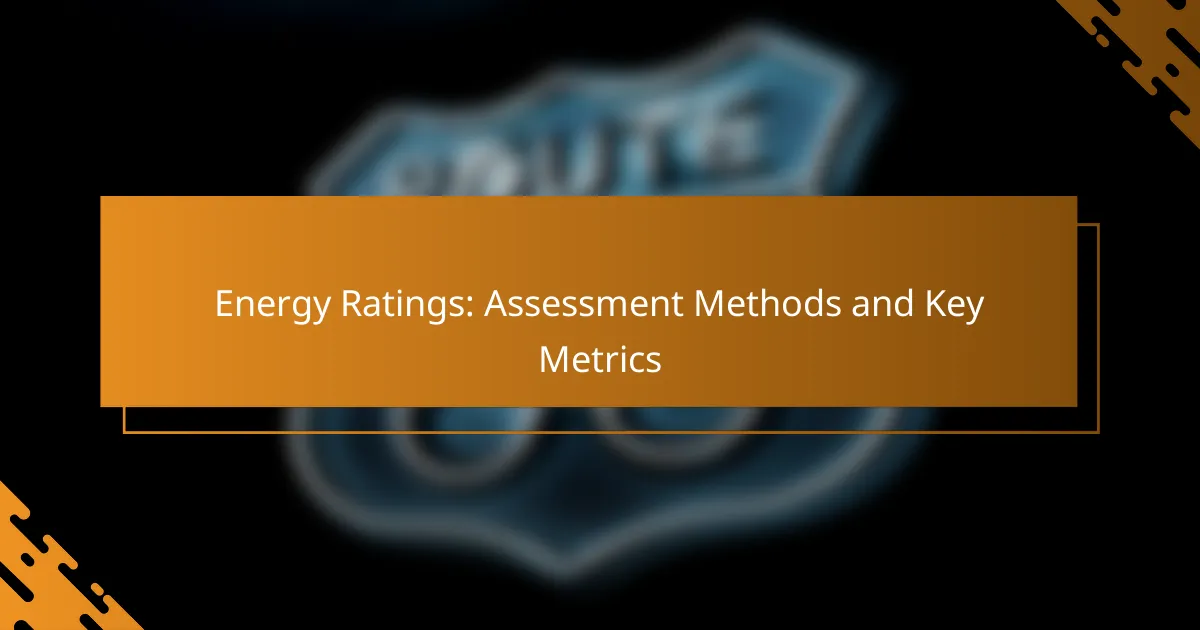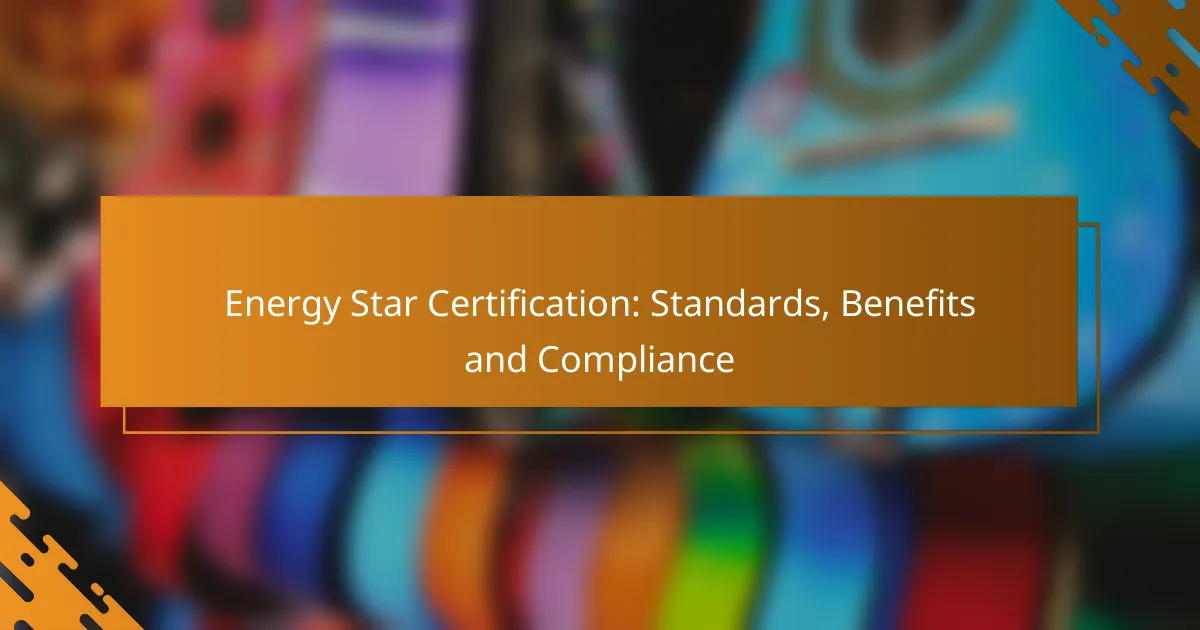Creating an energy-efficient home environment is essential for reducing energy consumption and enhancing overall comfort. By focusing on design elements, advanced technologies, and strategic practices, homeowners can significantly lower their utility bills while contributing to a more sustainable future.
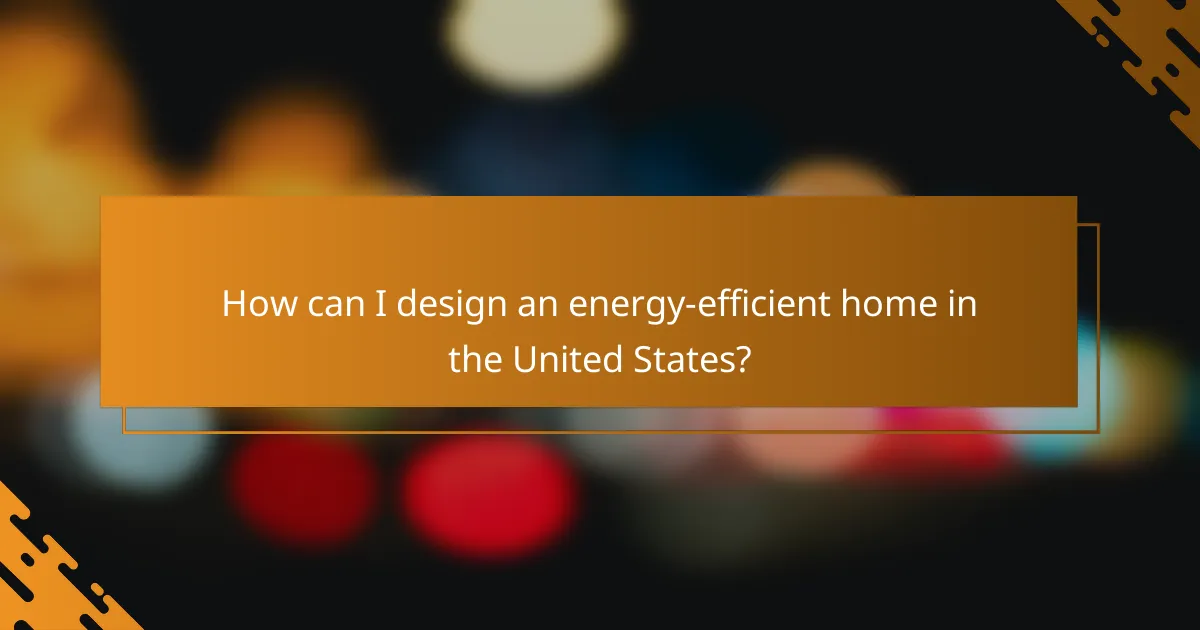
How can I design an energy-efficient home in the United States?
Designing an energy-efficient home in the United States involves integrating various strategies that reduce energy consumption while enhancing comfort. Key elements include optimizing orientation, selecting appropriate materials, and incorporating technology that maximizes energy efficiency.
Passive solar design
Passive solar design harnesses sunlight for heating and cooling without mechanical systems. This approach involves positioning windows and walls to capture solar energy, using thermal mass materials to store heat, and ensuring proper shading to reduce overheating in summer.
For example, south-facing windows can significantly increase natural light and warmth during winter months. Consider using overhangs or awnings to block high summer sun while allowing low winter sun to enter.
Insulation materials
Choosing the right insulation materials is crucial for maintaining a comfortable indoor temperature and reducing energy costs. Common insulation types include fiberglass, foam board, and spray foam, each with varying R-values, which measure thermal resistance.
In the U.S., aim for insulation with an R-value appropriate for your climate zone, typically ranging from R-30 to R-60 in attics. Proper installation is essential; gaps or compression can significantly reduce effectiveness.
Energy-efficient windows
Energy-efficient windows minimize heat loss and gain, contributing to overall energy savings. Look for windows with double or triple glazing, low-emissivity (Low-E) coatings, and gas fills like argon or krypton to enhance insulation.
When selecting windows, consider the U-factor and Solar Heat Gain Coefficient (SHGC) ratings. For most U.S. climates, a U-factor below 0.30 and an SHGC that suits your heating and cooling needs are ideal.
Smart home technology
Smart home technology enhances energy efficiency by allowing homeowners to monitor and control energy use remotely. Devices such as smart thermostats, lighting systems, and energy monitors can optimize energy consumption based on usage patterns.
For instance, a smart thermostat can adjust heating and cooling schedules based on when you are home, potentially saving 10-15% on energy bills. Ensure compatibility with your existing systems for seamless integration.
Landscaping for energy savings
Landscaping plays a vital role in energy efficiency by providing natural windbreaks and shade. Strategically planted trees and shrubs can reduce heating costs in winter and cooling costs in summer by blocking harsh winds and providing shade.
Consider planting deciduous trees on the south and west sides of your home to block summer sun while allowing winter sunlight to warm your home. Native plants require less water and maintenance, further enhancing sustainability.
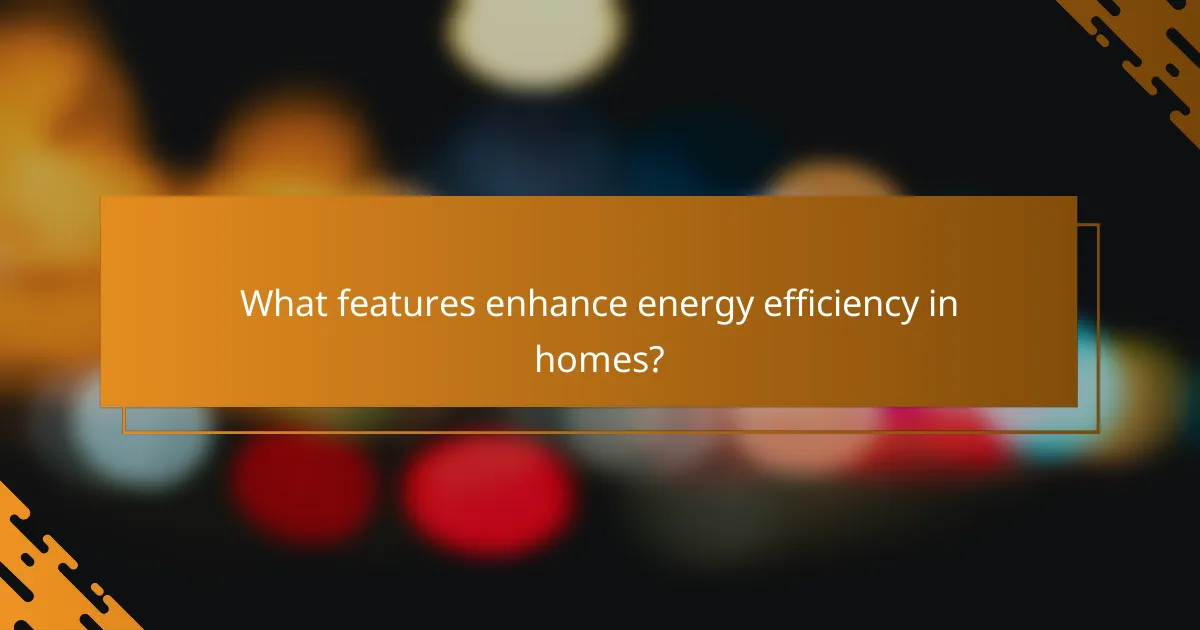
What features enhance energy efficiency in homes?
Key features that enhance energy efficiency in homes include advanced lighting systems, energy-efficient appliances, and high-performance HVAC systems. Implementing these elements can significantly reduce energy consumption and lower utility bills.
LED lighting systems
LED lighting systems are highly energy-efficient, using up to 75% less energy than traditional incandescent bulbs. They have a longer lifespan, often lasting over 25,000 hours, which reduces replacement costs and waste.
When choosing LED lights, consider the lumen output to ensure adequate brightness. Look for products with the ENERGY STAR label for verified efficiency and performance. Switching to LED can lead to noticeable savings on electricity bills.
Energy Star appliances
Energy Star appliances are designed to use less energy and water, making them a smart choice for eco-conscious homeowners. These appliances typically consume 10-50% less energy than standard models, contributing to lower utility costs.
When purchasing appliances, check for the Energy Star certification, which indicates compliance with strict efficiency guidelines. Investing in these appliances can yield significant savings over time, especially in high-use items like refrigerators and washing machines.
High-efficiency HVAC systems
High-efficiency HVAC systems are crucial for maintaining comfortable indoor temperatures while minimizing energy use. These systems often feature variable-speed motors and advanced thermostats, which optimize energy consumption based on demand.
Consider systems with a Seasonal Energy Efficiency Ratio (SEER) rating of 15 or higher for cooling and an Annual Fuel Utilization Efficiency (AFUE) of 90% or more for heating. Regular maintenance, such as changing filters and scheduling professional inspections, can further enhance efficiency and prolong the system’s lifespan.

What strategies can reduce energy consumption?
Implementing effective strategies can significantly lower energy consumption in homes. These approaches include regular maintenance, conducting energy audits, and making behavioral changes that promote energy efficiency.
Regular maintenance
Regular maintenance of home systems, such as heating, ventilation, and air conditioning (HVAC), is crucial for energy efficiency. Keeping filters clean, checking for leaks, and ensuring that systems are functioning optimally can prevent energy waste.
Homeowners should schedule maintenance checks at least once a year, ideally before the heating or cooling season begins. This proactive approach can help identify issues early and avoid costly repairs while ensuring systems operate efficiently.
Energy audits
Conducting energy audits helps identify areas where energy is being wasted and provides actionable recommendations for improvements. A professional auditor will assess insulation, windows, and appliances to determine their efficiency levels.
Homeowners can expect to receive a report detailing the audit findings, including potential upgrades and estimated savings. Many utility companies offer incentives or rebates for completing energy audits, making this an economically viable option.
Behavioral changes
Simple behavioral changes can lead to significant energy savings. Turning off lights when leaving a room, unplugging devices not in use, and using energy-efficient settings on appliances can all contribute to lower energy bills.
Encouraging family members to adopt these habits can create a culture of energy conservation at home. Setting reminders or using smart home technology can help reinforce these changes and make energy-saving practices a routine part of daily life.
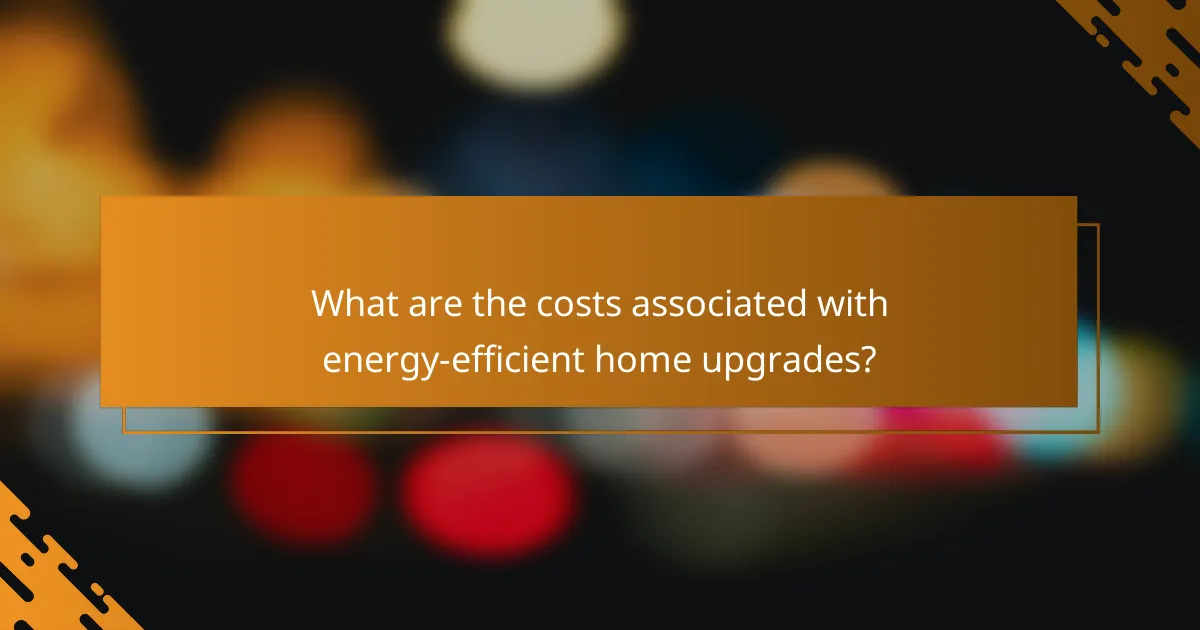
What are the costs associated with energy-efficient home upgrades?
The costs of energy-efficient home upgrades can vary widely depending on the type and extent of the improvements. Homeowners should consider both the initial investment and potential long-term savings when evaluating these upgrades.
Initial investment
The initial investment for energy-efficient upgrades can range from a few hundred to several thousand dollars. Common upgrades include better insulation, energy-efficient windows, and high-efficiency heating and cooling systems. It’s essential to assess the costs of materials and labor, as well as any potential disruptions during installation.
For example, replacing old windows with energy-efficient models may cost between 300 to 1,000 USD per window, depending on the style and materials chosen. Homeowners should obtain multiple quotes to ensure competitive pricing.
Long-term savings
Long-term savings from energy-efficient upgrades can be significant, often resulting in reduced utility bills. Homeowners may save anywhere from 10% to 50% on their energy costs, depending on the upgrades made and local energy prices.
For instance, installing a programmable thermostat can lead to savings of around 180 USD per year, while upgrading to energy-efficient appliances may save an additional 100 to 300 USD annually. These savings can offset the initial investment over time.
Financing options
Homeowners have several financing options for energy-efficient upgrades, including personal loans, home equity loans, and government incentives. Many local and federal programs offer rebates or tax credits to help offset costs, making upgrades more affordable.
Consider exploring options like Energy-Efficient Mortgages (EEMs), which allow borrowers to finance energy improvements as part of their home loan. Additionally, some utility companies provide financing plans that enable homeowners to pay for upgrades through their monthly bills.

How do I choose the right energy-efficient products?
Choosing the right energy-efficient products involves assessing your specific needs, understanding product ratings, and considering long-term savings. Look for items that meet recognized efficiency standards and fit your home’s requirements.
Understand Energy Ratings
Energy ratings provide a clear indication of a product’s efficiency. Look for labels such as ENERGY STAR in the U.S. or A+++ in the EU, which signify that the product meets high efficiency standards. These ratings can help you compare similar products easily.
When evaluating appliances, consider both the initial cost and the estimated energy savings over time. For example, a higher upfront investment in an ENERGY STAR-rated appliance can lead to significant savings on utility bills.
Consider Your Home’s Needs
Your home’s layout and climate play a crucial role in selecting energy-efficient products. For instance, in colder climates, investing in high-quality insulation and energy-efficient heating systems is essential. In warmer areas, focus on cooling systems and reflective roofing materials.
Assess your current energy consumption to identify areas for improvement. This might involve upgrading to LED lighting, installing smart thermostats, or using energy-efficient windows to reduce heating and cooling costs.
Evaluate Long-Term Savings
While energy-efficient products may have a higher initial cost, they often lead to lower energy bills and reduced maintenance costs over time. Calculate the payback period for each product to understand when you will start seeing savings.
For example, if a new heating system costs $3,000 and saves you $300 annually on energy bills, your payback period is about ten years. Consider financing options or rebates that can help offset initial costs.
Research Rebates and Incentives
Many governments and utility companies offer rebates or tax incentives for purchasing energy-efficient products. Research available programs in your area to maximize your savings. These incentives can significantly reduce the upfront costs of energy-efficient upgrades.
Check local regulations and programs that may provide additional support for energy-efficient home improvements. This can include grants or low-interest loans specifically designed to encourage energy efficiency.


